Mandatory climate-related financial disclosure is becoming a universal reality, with more governments around the world adopting the recommendations of the Task Force on Climate-related Financial Disclosures (TCFD) and the International Sustainability Standards Board. In parallel, more companies are setting targets and developing strategies to do their part in meeting the global objective of minimizing global warming to 1.5°C by 2050. Climate transition plans and greenhouse gas (GHG) emissions disclosures are challenging for investors to understand and compare across industries and geographies. Investors acknowledge that to meaningfully assess transition risks, it is important to look beyond stated commitments to evaluate the actions companies are taking to manage climate risks and opportunities.
Morningstar Sustainalytics’ Low Carbon Transition Ratings provide investors with a top-level implied temperature rise and value-at-risk, assessing companies’ current alignment to a net-zero pathway. The ratings are supported by robust research and a transparent dataset, including annual expected emissions trajectories for different climate change scenarios.
Leveraging our Low Carbon Transition Ratings, investors can respond to regulatory initiatives, implement net-zero strategies, fulfill client net-zero mandates, conduct scenario analysis, and obtain transparency into company actions by integrating climate research into their investment decision-making processes.
Latest Insights
ESG in Conversation: When It Comes to Sustainable Investing, It's A Material World
Material Matters: The Role of ESG Materiality in Sustainable Investment Strategies
The SEC’s New Rules on Climate
Overview of Sustainalytics’ Low Carbon Transition Ratings
Our comprehensive framework measures the degree to which a company’s projected GHG emissions differ from various decarbonization policy scenarios between now and the year 2050. The ratings leverage a two-dimensional framework that measures an issuer’s exposure from their expected emissions, while also accounting for management actions. They assess the company’s progress toward their stated net-zero commitments by evaluating the quality and ambition of their GHG reduction targets, as well as any demonstrated short-term investment plans, policies and programs such as Climate Transition Resilience Program, Product Decarbonization Strategy and a GHG Emissions Reduction Policy – Supply Chain. The ratings also provide a Climate Transition Value-at-Risk signal that demonstrates the potential loss in value that a company may experience from a transition to a low carbon economy, calculated for different decarbonization pathways.
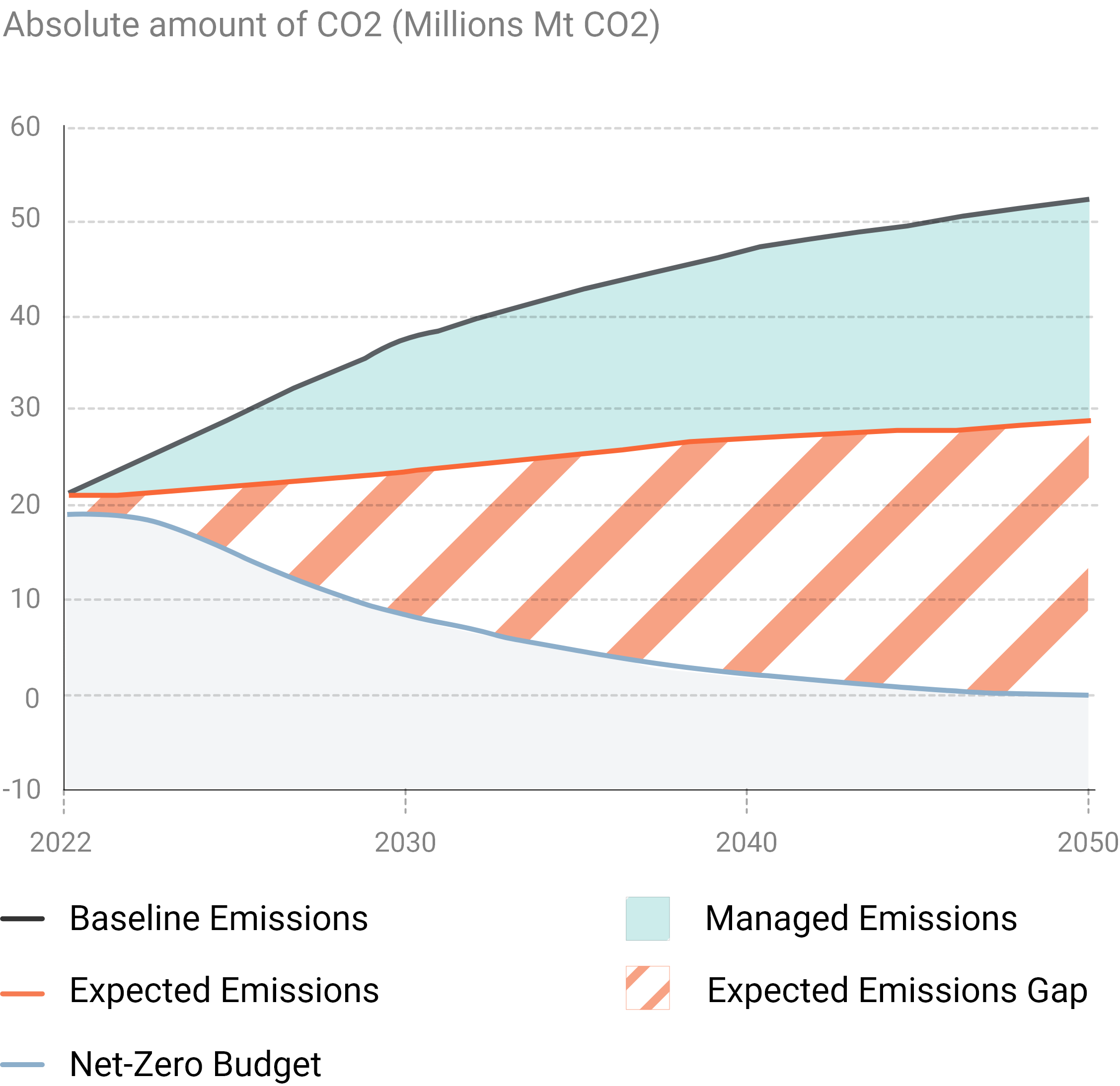
Comprehensive Measure of Low Carbon Transition Alignment
Analyze low carbon transition exposure and management preparedness across a business’ value chain for each scope of emissions. Our assessment delivers more than just an Implied Temperature Rise rating, going beyond by looking at a company’s ambitions and targets. Investors can identify areas where each issuer is performing well and opportunities for improvement.
Analyze Expected Issuer Emissions Against Various Net-Zero Climate Scenario
Our Low Carbon Transition Ratings are driven by a bottom-up scenario analysis, evaluating companies’ emission trajectories against expected regional policy and technology pathways required to meet the Paris Agreement and net-zero ambitions by the year 2050. This currently includes orderly scenarios like the UN PRI IPR Required Policy Scenario (RPS)*, and IEA Net Zero 2050 Scenario (NZE), a disorderly scenario with the IPR Forecast Policy Scenario (FPS), and a hot-house scenario with IEA Stated Policies Scenario (STEPS).
*The 1.5°C Required Policy Scenario (RPS) is from the UN PRI commissioned Inevitable Policy Response (IPR).
Support Investor TCFD Reporting and Assess Issuer Disclosure
Paired with our Physical Climate Risk Metrics and Carbon Emissions Data solutions, our Low Carbon Transition Ratings enable investors to meet most TCFD recommendations. Additionally, investors receive a detailed assessment of issuer TCFD disclosure with respect to their quality of management across each thematic area of the TCFD.
Access our Transparent Methodology and Granular Data
Our Low Carbon Transition Ratings are underpinned by a transparent methodology, multiple levels of data and clear indicator guidance, which allows for validation and customization of the weighted data points to generate unique insights that align to investors’ objectives.
Holistic Integration of Management Preparedness
With more than 85 general and subindustry-specific management indicators – weighted by a company’s distribution of GHG emissions across Scopes 1, 2, 3 upstream, and 3 downstream – investors gain transparency into the credibility of company’s transition plans and management preparedness and can integrate granular climate insights into their company assessments and valuation models.
Ratings Expressed as Implied Temperature Rise
The top-level ratings are expressed as a simple contextualized signal, estimating the Implied Temperature Rise of issuers’ current low carbon transition performance. This expresses what global temperatures could rise to if the whole economy had the same percentage of misaligned emissions between now and the year 2050. This output enables investors to seamlessly categorize and compare different levels of performance across issuers.
Dedicated Module to Assess Issuer Disclosure with TCFD
A TCFD module module is included in the rating to assess and track the completeness of issuer reporting and translate our assessment of issuers’ managerial preparedness across the four thematic areas recommended by the TCFD (governance, strategy, risk management, and metrics and targets).
Integrated Asset Impact Data
More accurately assess how companies are managing their net-zero transition. Estimate the impact of current CapEx on future investment alignment among the 9 highest emitting sectors including utilities, construction materials, and transportation.
8,000+ Companies Covered
Sustainalytics' Low Carbon Transition Ratings span more than 8,000 companies and encompass most major global indices. Future expansion of the company database will align with the coverage of our ESG Risk Ratings.
Flexible Accessibility
The Low Carbon Transition Ratings are available through Global Access with screening and reporting tools, data-feeds, and application programming interface (API). They will be made available for several third-party distribution platforms in the future.
Analysis of Issuer's Transition Value at Risk
Value at Risk (VaR) is a financial metric that demonstrates the expected future impact on a company’s bottom line due to the transition to a low carbon economy. VaR is measured based on the policy costs of expected emissions and the impact of reduced market demand, where applicable. It is a cumulative value based on a discounted cash flow model for the years from now until 2050 that allows users to complete regulatory reporting, stress testing, scenario analysis, and portfolio optimization.
Learn more about our Low Carbon Transition Ratings
To learn more about our Low Carbon Transition Ratings, view the video message from our Senior Vice President of Climate Solutions, Azadeh Sabour.
About Our Framework
We start with a baseline projection, which is based on corporate reporting and estimation modelling across all 3 scopes of emissions, including both the upstream and downstream segments of scope 3.
Next, we consider how the quality of the company's policies and programs, strategy, governance, and financial position affect the baseline emissions.
This emissions projection is based on a company's baseline emissions in combination with their managed emissions.
This is the company's sector- and region-specific budget required to align to a net-zero emissions pathway by 2050.
The expected emissions gap reflects the emissions that are not managed and indicates the severity of misaligned emissions.
The Expected Emissions Gap reflects the emissions that are not managed and indicates the severity of misaligned emissions.

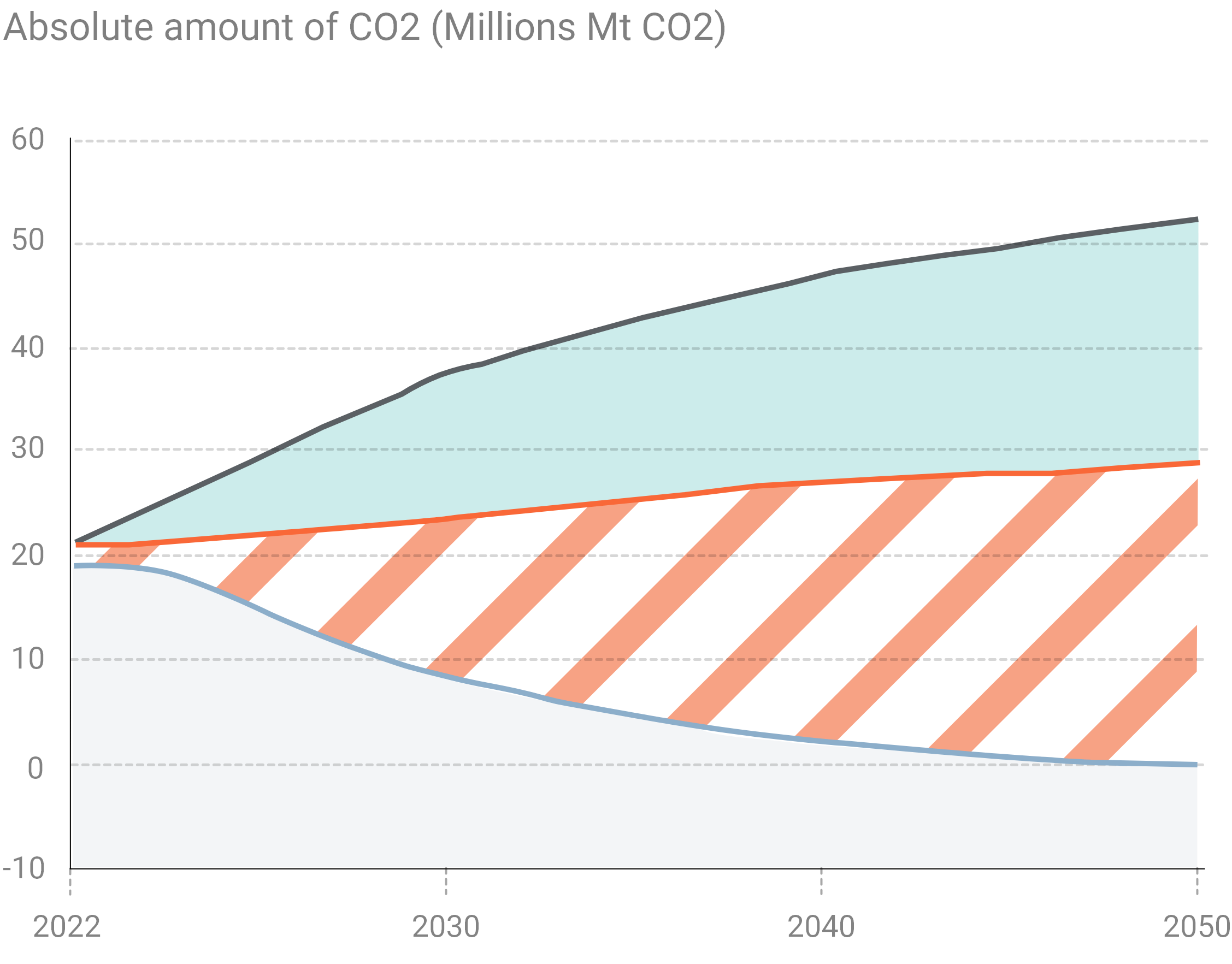
Expected Emissions Gap Calculation
| Cumulative Emissions to 2050 (CO2) | |
|---|---|
| Expected Emissions | 765 Mt |
| Net-Zero Budget | 211 Mt |
| Expected Emissions Gap | 553 Mt (+261%) |
| Implied Temperature Rise Score | 2.4ºC |
| Implied Temperature Rise Category | Significantly Misaligned |
Use Cases
Climate Research Integration
- Measure alignment of companies against a 1.5°C scenario
- Deepen insights into transition risk and opportunities for portfolio management
- Conduct scenario analysis – compare value at risk for different decarbonization pathways
Implement Net-Zero Strategies
- Assess forward-looking carbon emissions of companies, portfolios, funds, and benchmarks with net-zero pathways.
- Meet commitments of global alliances and member groups such as the Net Zero Asset Manager Initiative and the Institutional Investors Group on Climate Change (IIGCC).
Screening and Benchmarking
- Set decarbonization targets and monitor performance.
- Screen investable universe based on company exposure to, and/or management of, transition risks.
- Conduct credibility assessments of company transition plans and assess SBTi Readiness
Reporting & Client Communication
- Support TCFD-aligned regulatory reporting.
- Report to clients on how portfolios are aligned with global climate goals.
- Respond to client net-zero mandates.
Engagement and Voting
- Evaluate company management of transition risks and opportunities.
- Obtain transparency on corporate’s disclosure sufficiency to current TCFD recommendations.
Thematic Investing
- Create climate-aware investment products.
Report Insights
A company’s top-level rating is expressed as an Implied Temperature Rise signifying the expected level of global warming if the global economy had the same proportion of emissions misaligned to the net-zero budget. The absolute emissions gap across each scope of the company’s business activity are summarized through time series graphs, with the underlying components of the assessment illustrated in decomposition charts.
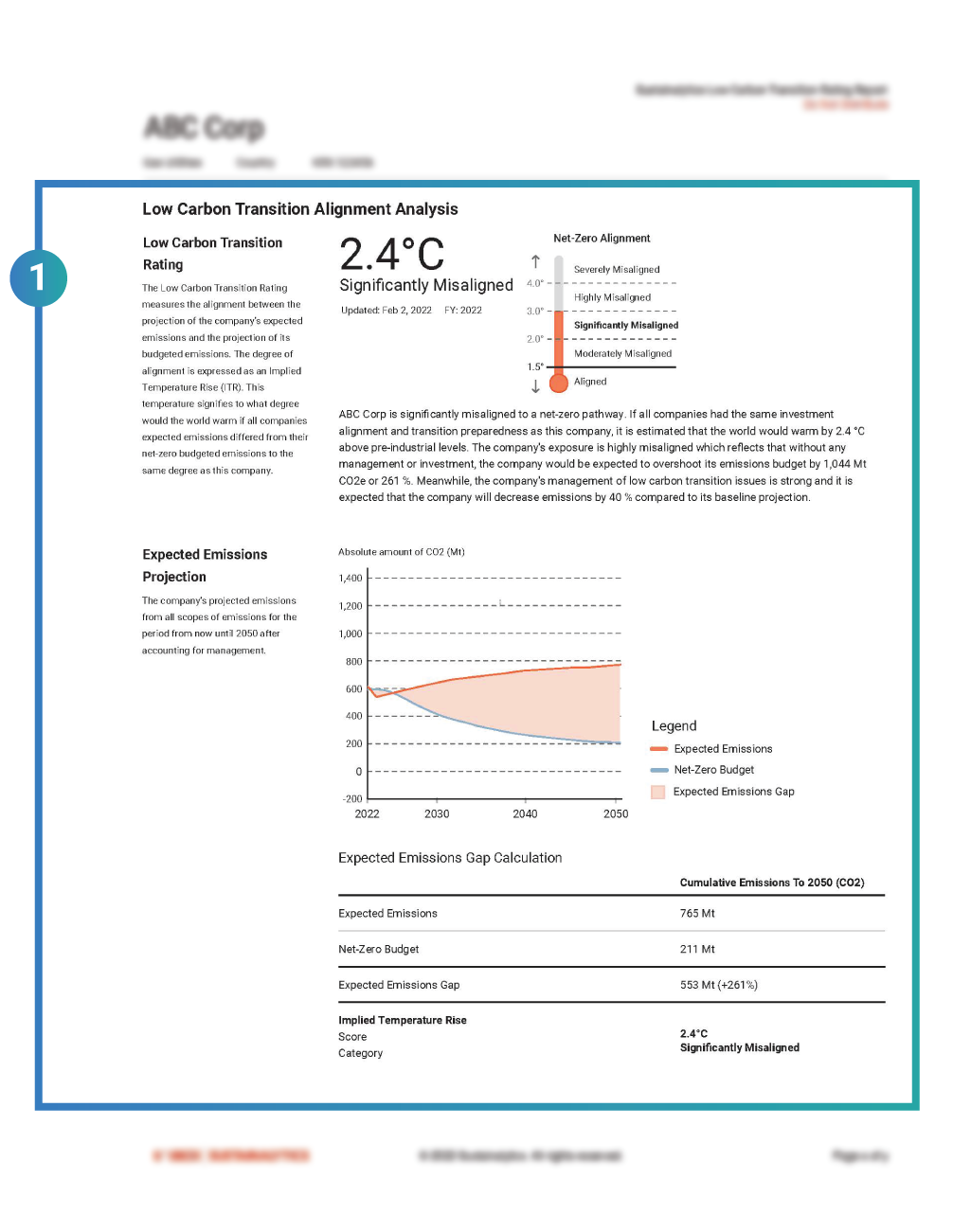
The degree of overall alignment to the net-zero budget is summarized for each scope of emissions across an issuer’s value-chain, providing transparency into how much each scope of emissions is contributing to the overall rating. A separate value-chain analysis for each of the exposure and management components is also provided.
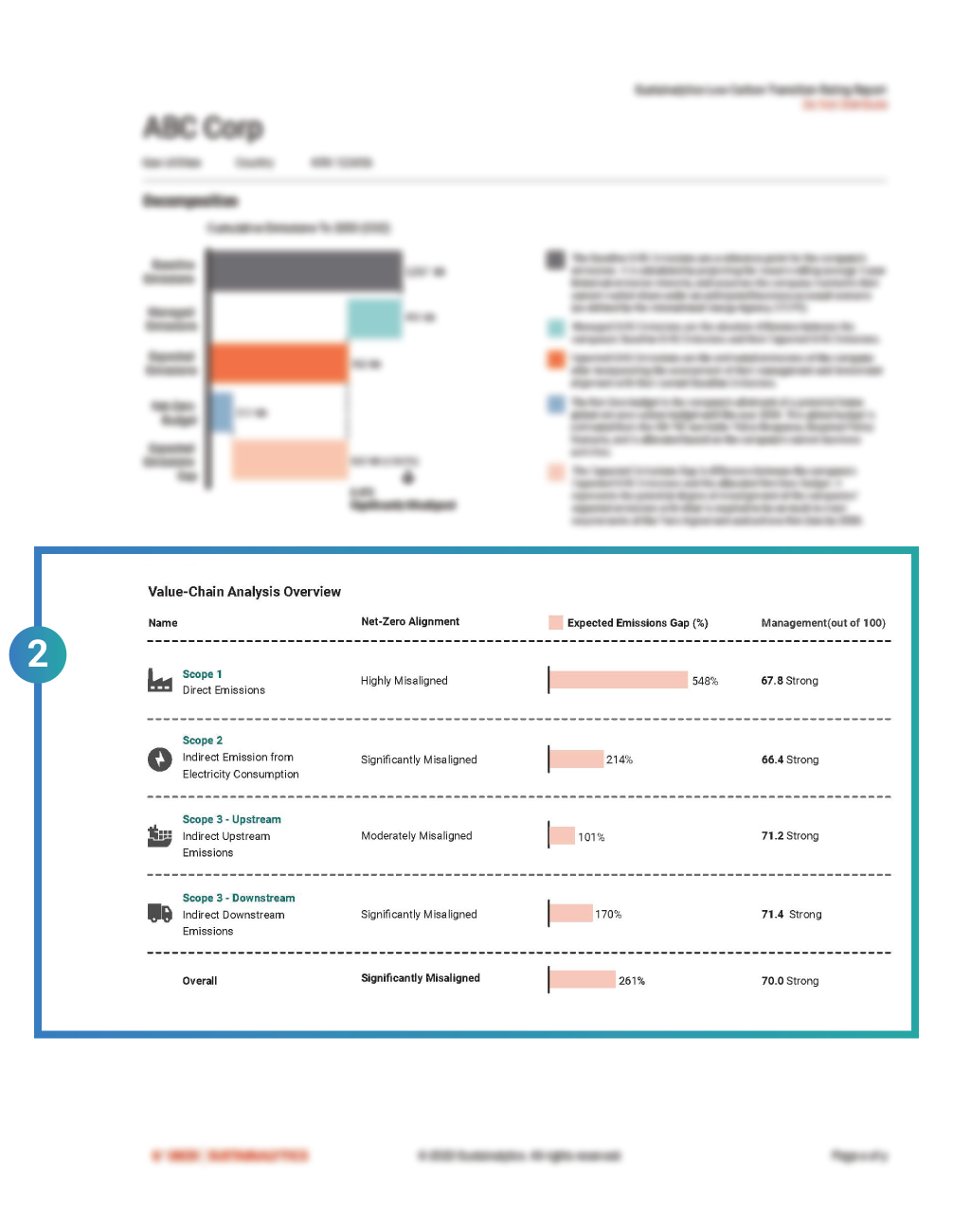
The issuer’s rating is analyzed in context of their peers in global public equity and bond markets, as well as industry and sub-industry specific peers. The issuer’s top peers by market capitalization are summarized with a view of their overall rating, Exposure and Management scores.
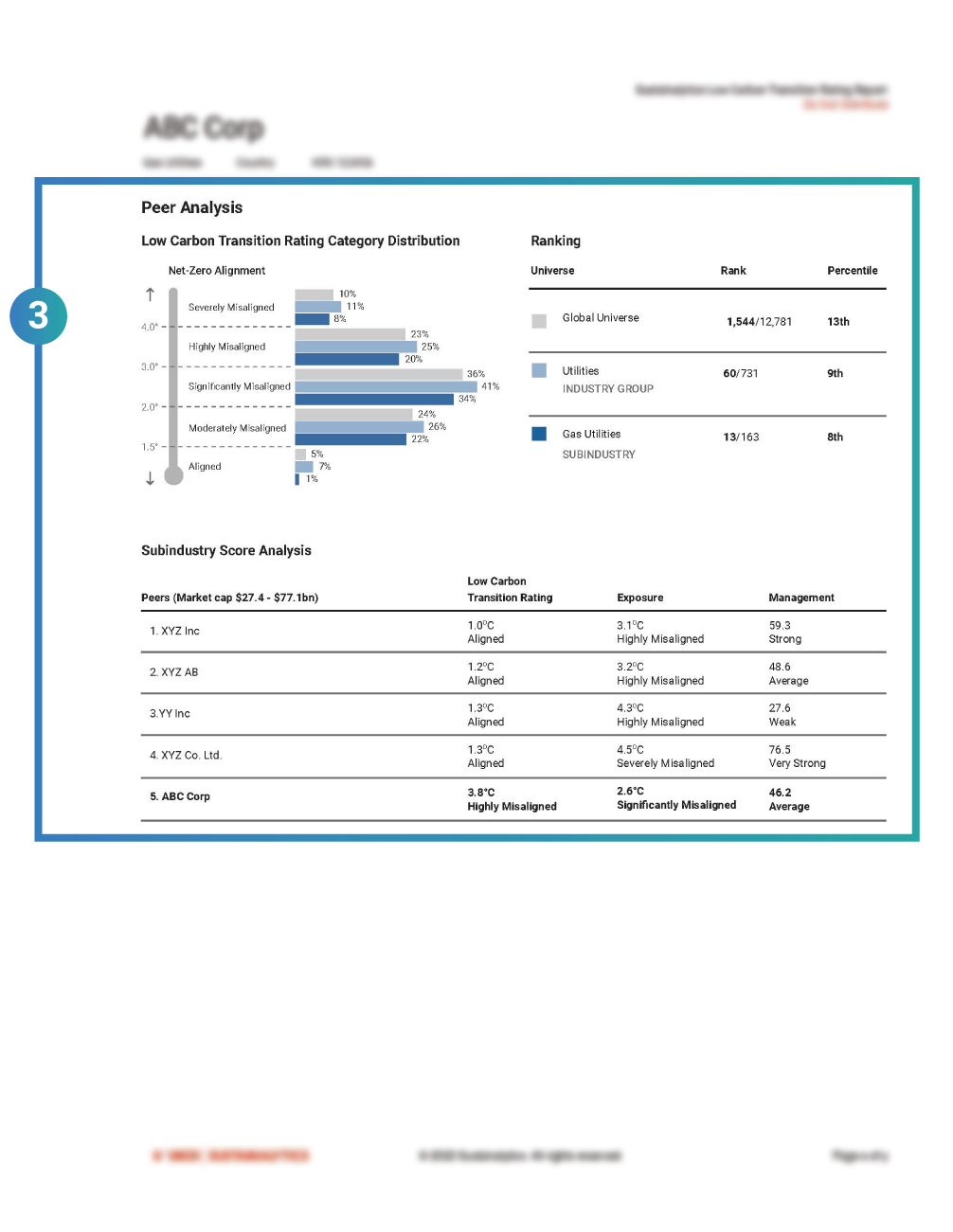
An overall management score out of 100 is provided, as well as an analysis identifying where action may be needed across the issuer's business activities. This is communicated through a breakdown of their management scores and contribution of key management indicators for each scope of emissions across the issuer’s value chain.
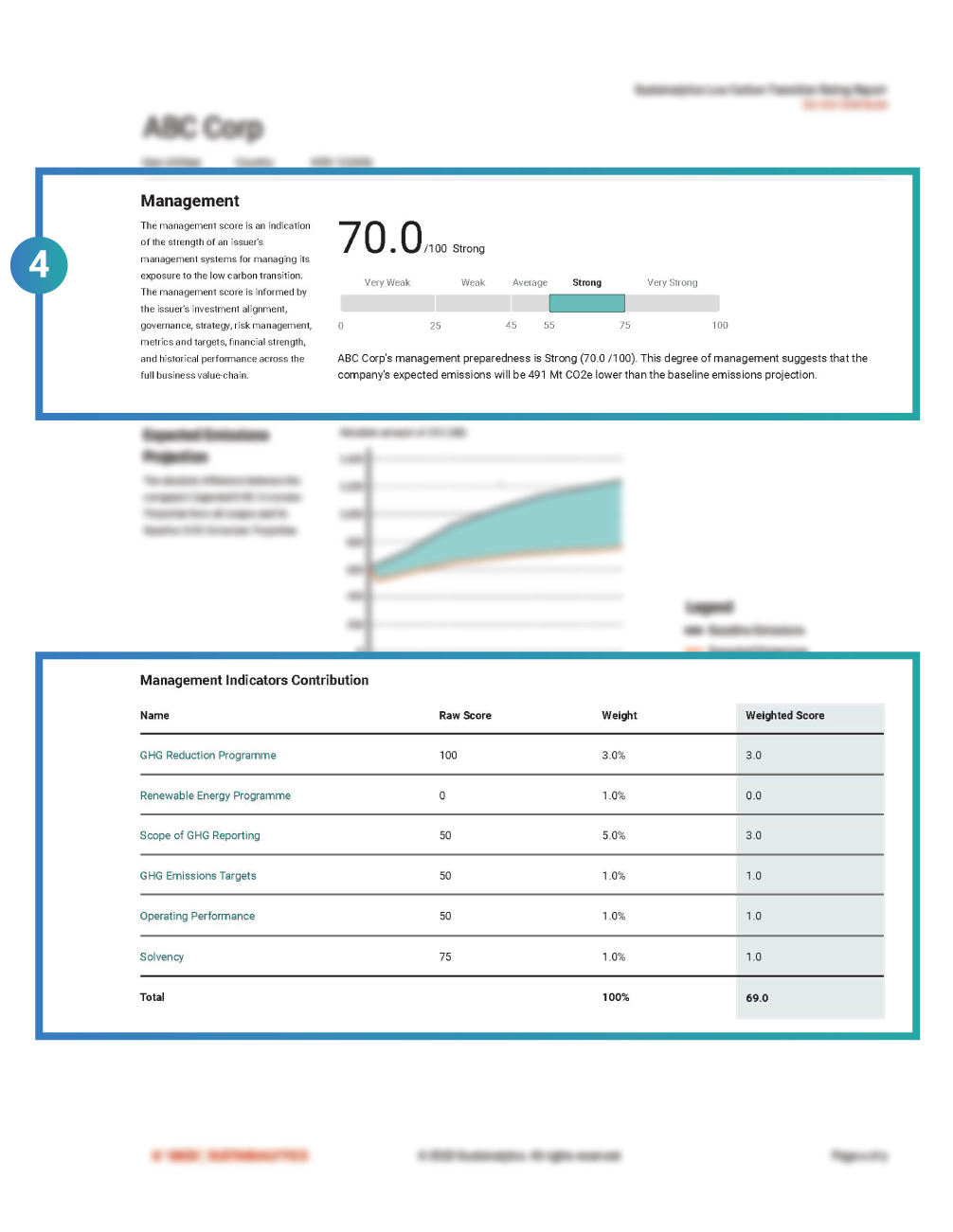
An overall score of the comprehensiveness of issuers’ climate related disclosures, and a detailed analysis across the key TCFD thematic areas of governance, strategy, risk management and metrics & targets provides transparency into quality of their management.
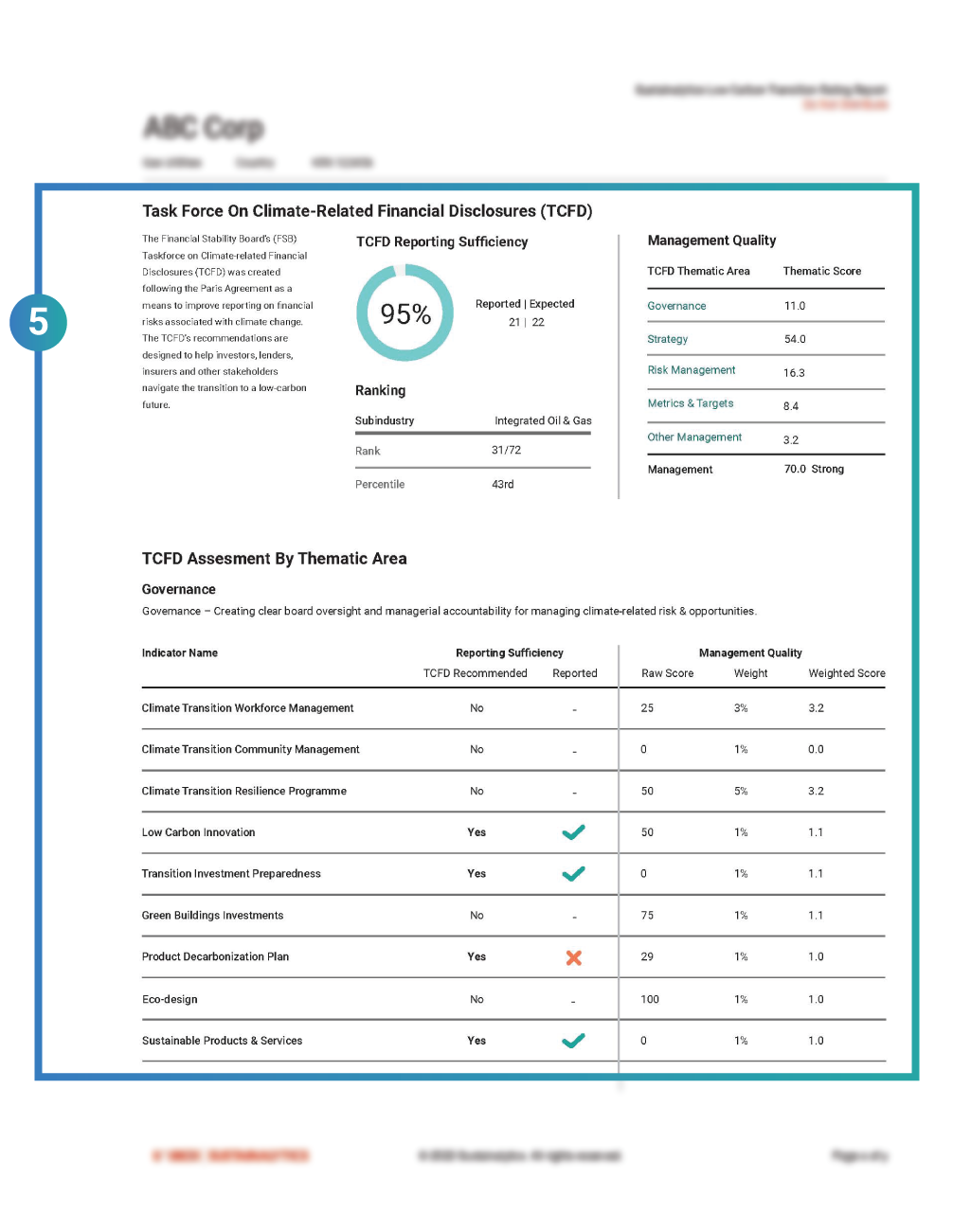
Low Carbon Transition Value at Risk (VaR) informs investors about potential future losses their portfolio companies may face due to their exposure and management of the transition to a low carbon economy. By taking into account the policy costs of expected emissions, and the impact of reduced market demand for fossil fuels, VaR enables investors to respond to regulatory requirements, perform stress testing, and optimize their portfolio for transition scenarios.
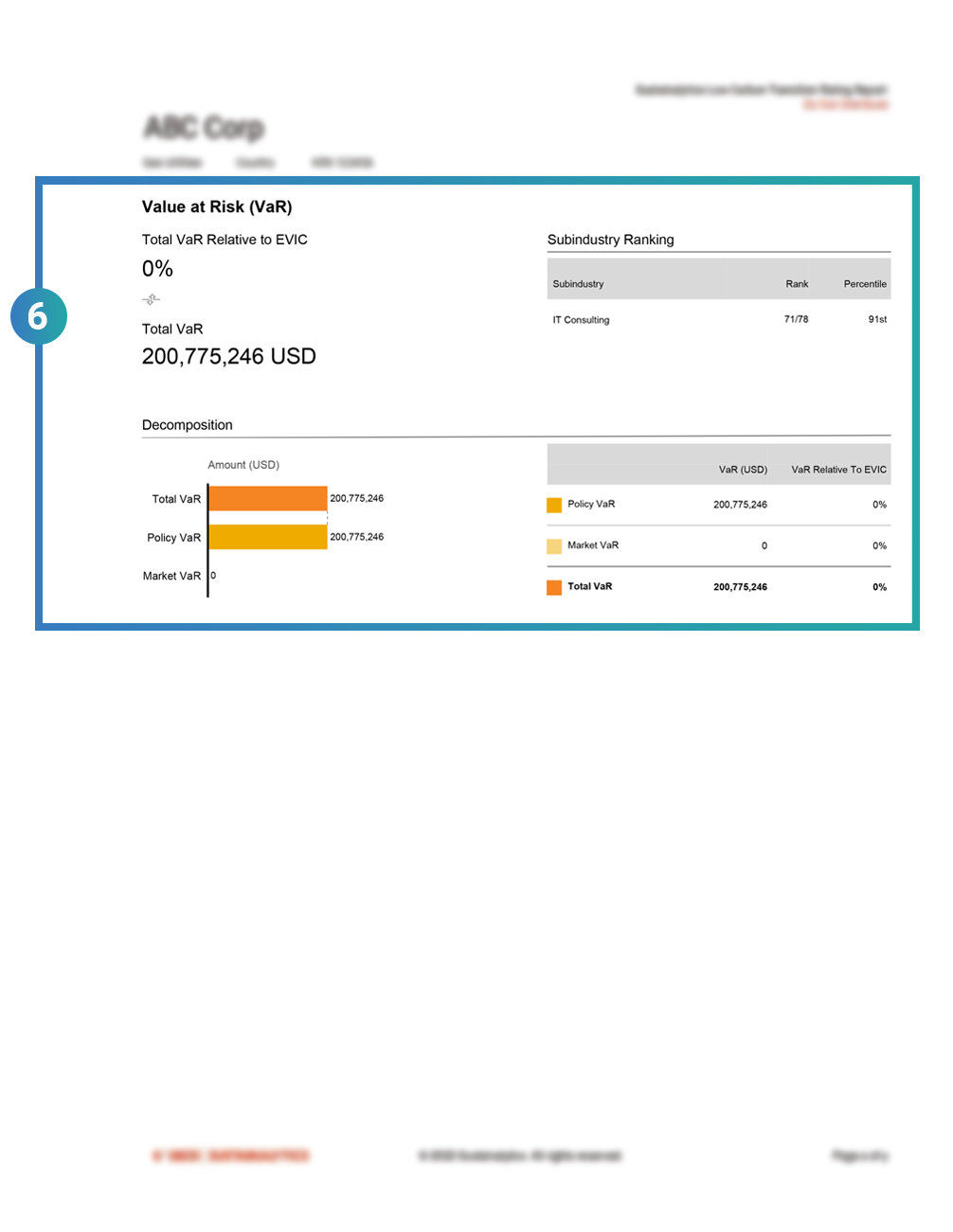





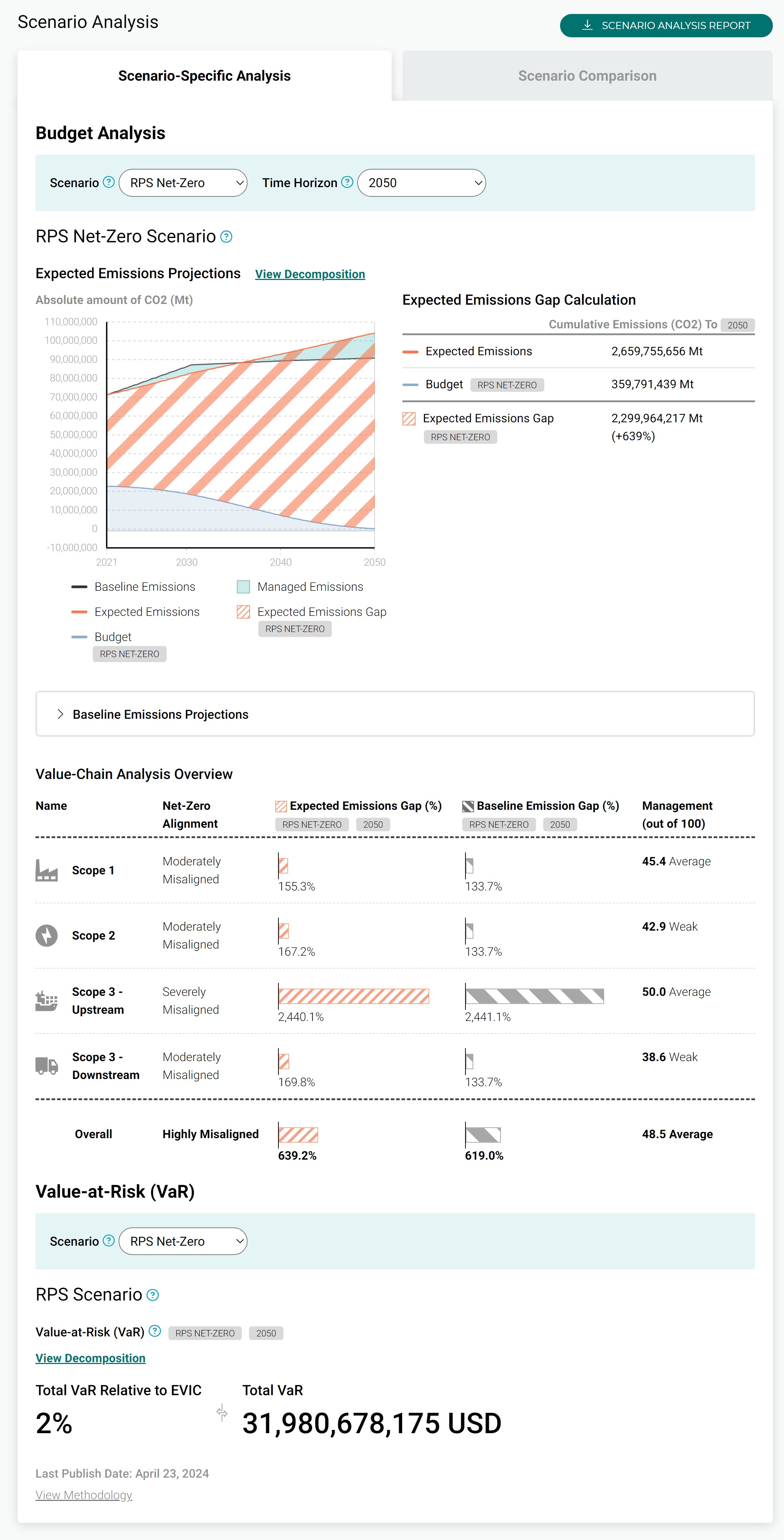
Why Sustainalytics?
A Single Market Standard
Consistent approach to ESG assessments across the investment spectrum.
Award-Winning Research and Data
Firm recognized as Best ESG Research and Data Provider by Environmental Finance and Investment Week.
End-to-End ESG Solutions
ESG products and services that serve the entire investment value chain.
30 Years of ESG Expertise
800+ ESG research analysts across our global offices.
A Leading SPO Provider
As recognized by Environmental Finance and the Climate Bonds Initiative.
Related Products

Carbon Emissions Data
Evaluate and analyze companies’ GHG emissions across scope 1, 2, and 3 emissions.
Learn MoreMorningstar Low Carbon Transition Leaders Indexes
Gain diversified broad market exposure to companies leading their sector peers in their readiness for — and action towards — climate transition.
Learn More
Physical Climate Risk Metrics
Assess and disclose the direct and indirect physical climate risks of climate change related exposure.
Learn MoreRelated Insights and Resources
Six Best Practices Followed by Industries Leading the Low Carbon Transition
In this article, we take a closer look at the leading industries under the Morningstar Sustainalytics Low Carbon Transition Rating (LCTR) and examine the best practices that have allowed them to emerge as leaders in managing their climate risk.
Navigating the EU Regulation on Deforestation-Free Products: 5 Key EUDR Questions Answered About Company Readiness and Investor Risk
The EUDR comes into effect in December 2024, marking an important step in tackling deforestation. In this article, we answer five key questions who the EUDR applies to, how companies are meeting the requirements, and the risks non-compliance poses to both companies and investors
Beyond 1.5 Degrees: What the LCTR Tells Us About Companies Managing Their Climate Risk
The LCTR rating of over 8,000 companies shows that global temperatures will rise 3.1 degrees Celsius over pre-industrial averages. This article looks at the overall performance of these companies and the industries that are leading on climate.








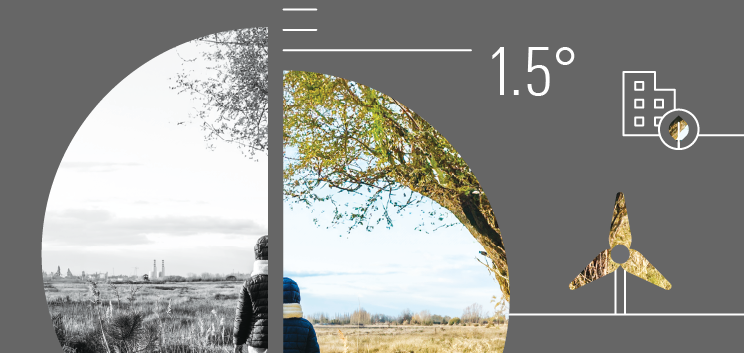

-5-key-questions-answered-about-company-readiness-and-investor-risk.tmb-thumbnl_rc.jpg?Culture=en&sfvrsn=ee2857a6_2)
